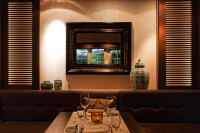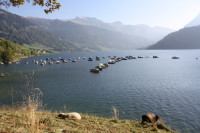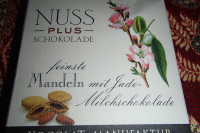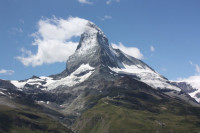Music
A visit to the Zurich Opera House
The Zurich Opera House is celebrating this year its 120th anniversary. The first opera performed there was “Lohengrin”on October 1, 1891, a long opera in three acts by German composer Richard Wagner.
The Opera House, which took its present name only in 1964 (before called Stadttheater), was not the the first one in the city. Another theater, the Actientheater, had been built on the same spot in 1834, on the Sechseläutenplatz in Bellevue. When the theater burnt down on New Year’s Eve of 1889/90, the Zurichers wanted the theater to be rebuilt immediately. They bought for the new theater the plans originally made for the Polish Opera House in Krakow. It reopened on September 30th, 1891 with a formal ceremony.
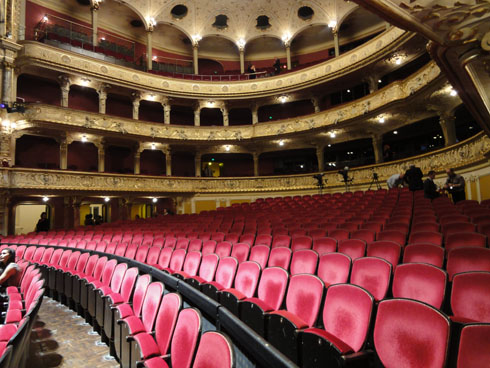
Auditorium of the Opera House
The architects of the Zurich Opera House were Austrians, two Viennese, Ferdinand Fellner and Hermann Helmer. They used 1800 oak pillars to prevent the new building from collapsing. They kept for the facade the previous Neo-classical look.
The entrance foyer is beautifully decorated in Rococo style resembling the Adelspalais in Vienna. The auditorium, in Rococo style as well, is large enough for 1200 people. J. Gärtner, P. Gastgeb and Karl Peyfuss decorated its ceiling. Their paintings are a representation of love, tragedy, comedy, music and poetry. The best place to sit for great acoustic is in the middle in the back second row.
The orchestra pit has room for a team of 110 musicians.
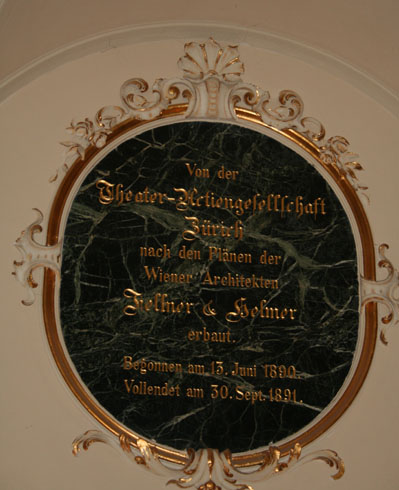
Name of the architects of the Zurich Opera House
I was led me with a group through the building by Fred, a retired lady from the Opera House.
Knowing that there are over 340 shows a year there, a good organisation and professionalism is important. Something is happening every evening: an opera, a ballet, a concert, a play, a musical, a workshop. There are about 13 opera premieres yearly. No other Opera House in the world has as many shows as in Zurich, not even the famous Scala in Milan or the Staadtoper in Vienna with only have 5 or 6 premieres a year. In addition the Zürcher Ballett has premieres. This season it will have 3 premieres.
Two to three shows are prepared at the same time. One repeats in the morning with one stage set and in the evening one installs a new set. A sets stays for a maximum of 2 to 3 hours.
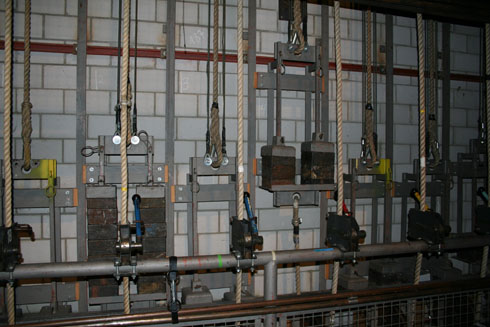
Behind the scenes of the Zurich Opera House
“The most important thing”, tells Fred, “is lighting”. Did you know that the Zurich Opera House was the first one in Europe to have electric lighting in 1891? Three teams of 10 people work on the lighting for the shows. Thirty people work just on lighting! It is a difficult task as there are hundred different positions for lighting the stage of the auditorium.
Fred brings us in a long and spacious lift on the 4th floor, leading into a storage room where boxes and floats are stored.
Then, we head to the rehearsal room, a place almost as big as the auditorium. Rehearsing is never done with original stage sets. The musicians don’t rehearse with the rest of the crew, they practice somewhere else. Only one rehearsal is done all together.
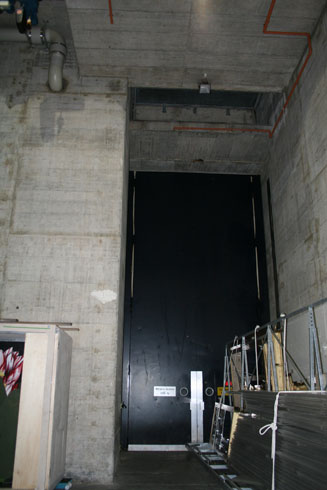
Large door in the Zurich Opera House
We end up in another storage room with very high doors, almost 26 feet tall (8 meters). About 11,000 pounds (5000 kilos) of materials can stay behind those doors. One can see in the front some glass bottles and some armchairs on top of each other. Things are stored there in the morning but last night they were used on the stage.
The stage sets are made to be transported on giant floats. The floats can fit in the lifts. Two teams of drivers spend their time bringing the stage sets to the Opera House and bringing them back to the storage room.
She brings us where the costumes for the shows of the moment are stored. She lets us look at them and wander through the many alleys. It is astonishing how many buttons, shoes, hats are there.
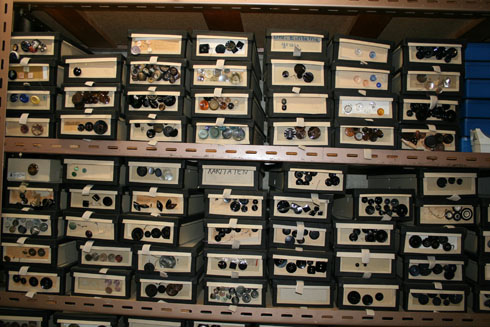
Zurich Opera House buttons in the storage room
But this is nothing comparable to the other big storage houses in Zurich.
For one opera, about 300 costumes have to be made. For a ballet it is a bit less about 200 costumes. Each costume is made for each individual person. The costumes designers make a drawing and choose the color and give the pattern to the sewing crew. Not all costumes are made in Zurich. The costumes for the soloists are made here but for the members of the choirs it is made where it is cheaper. Much work is done in China with the prototype for the costumes sent by the Zurich costumes designers.
With so many yearly shows a good storage system is needed because sometimes some decoration and costumes have to be stored for 16 years. Because some things are extremely hard to dismantle, it has to be left the way it is.
The Zurich Opera House found space in two huge storage houses in Oerlikon. It would be too expensive to store everything in Bellevue. In Oerlikon there are about 90,000 costumes and men shoes stored in one place and in the second one everything is for the women.
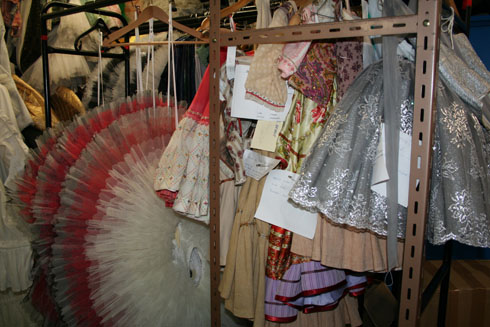
Ladies costumes in a storage room of the Zurich Opera House
When it is too much, it is sold, but it is extremely rare. Most of it is stored for future usage.
Fred says that the job as a ballet dancer is hard. They go on a plane, train for the show, dance and leave again. They have to change quickly during a show and most of the time they have no time to rest. The ladies often look exhausted.
About 200 ballet dancers come from all over the world to find a job in Zurich. Some even come from Tokyo. They dance 3 to 4 minutes and they know right away if they are taken or not.
Tour guide saw some female dancers touching their feet in pain, rubbing them with a cream or putting some bandages on them. She thought the dancer will not be able to dance, but she managed. Fred continues “if you don’t dance when you are in pain, you would never dance.”
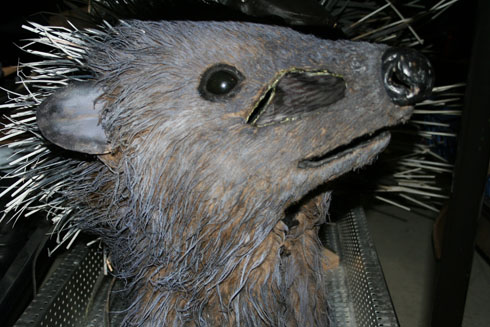
Animal mask
The Opera House also has prompters, five Maestri Suggeritori. They are young people, like pianists for instance or workers trained to be conductors, but who have not found work in their field. This a way to get in the door in hope to have some day a better job at the Opera House.
We pass in front of the costume designers room. It is a large room with about six, seven young women working in it. They signal they don’t want any pictures taken. I notice a list of measurement with names, weight, length of arms. It is quite interesting to see so many numbers for each individual needing a costume.
The Canton of Zurich subsidizes the Zurich Opera House. Before it was the city of Zurich. In 2009/2010 247,275 visitors came to the shows. But the money from the paying visitors, donation and the canton is not enough to pay for all expenses. In 2009/10 it lost CHF 4,9 Million.
Over 600 people work there full time; in addition there are special annual contracts. “This is enormous”, says Fred. The Opera House gives its workers tickets to go see each show. They receive 10 tickets for each Wednesday’s show, which they can give to friends if they want to.
The upcoming year will see some changes in the leading people of the Opera House. The director of the Opera House, Alexander Pereira, will be there for the season 2011/2012 until his contract runs out in summer 2012. He has been there for twenty years and will be replaced by Andreas Homoki. As well the director of the Zürcher Ballett, Heinz Spoerli, there since 1996, will be leaving too.
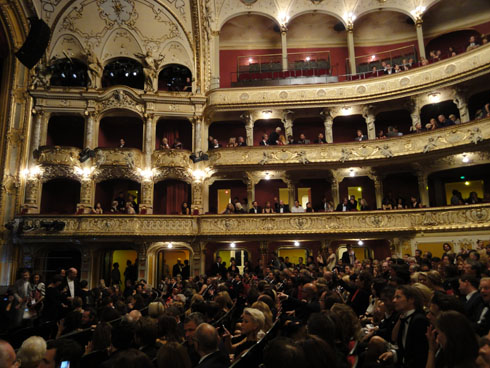
Zurich Film Festival award ceremony at the Zurich Opera House
For those interested in trying something new for the holiday season, check out the shows calendar for December. There will be among other things the ballet “Nutcraker” from Tchaikovsky, the “Magic Flute” from Mozart and the “Contes d’Hoffman” from Offenbach.
The Opera House also offers “Opera Viva” for children from age 7 to 14. It is a real success as it teaches them about operas in a fun way and they become the stars of the show and can come closer to the costumes and participate with the performers. There are six shows a year.
The season 2011/2012 is promising with the World Première on November 11th of German composer Anno Schreier with “die Stadt von Blinden”, a ballet “Dornröschen” from Tchaikovsky but also “Cosi Fan Tutte”(Mozart), “Carmen”(Bizet), “Don Giovanni” (Mozart), “Il Barbiere di Siviglia” (Rossini) and much more.
Enjoy the season at the Zurich Opera House.
Many thanks to Anna-Barbara Rothen working in PR/Marketing for the Opera House, who kindly responded to some questions.
